Who Was Barbie?
A symposium. Margot Robbie poses as Barbie in an homage to "2001: A Space Odyssey." Image: Warner Bros. Entertainment
Margot Robbie poses as Barbie in an homage to "2001: A Space Odyssey." Image: Warner Bros. Entertainment
When a movie becomes a mass culture phenomenon, like Barbie, any negative criticism of it runs the risk of coming off hysterical. Any meanness toward it becomes the mirror version of the reactions of fans who see the movie in the theater again and again, who cry during certain scenes each time, and who tell the world about it on social media with a great sense of pride and purpose, or even with a certain amount of shock about its power over them.
Similarly, rushing to write a takedown, a counter-phenomenon more prevalent with every big new release, shows the same shocked inability to hold it in—to think before writing. It’s not the love or the hate that bothers me—it’s the speed. Rushing to the keyboard isn’t pretty, even if you’re still dressed in pink. In the case of Barbie, the opposite of the hot pink take is dressed just as loud.
There’s a silent movie by Ernst Lubitsch from 1919 called The Doll, in which a woman has to pretend she’s a doll to her fiancé while also convincing him that she’s convincing a wedding party that she’s a real person (which she is). This strikes me as a more sophisticated approach to the gender bind than anything in Greta Gerwig’s Barbie, in which the doll-as-doll (Margot Robbie), now in the real world, goes up to a construction crew (the working class) to announce that she doesn’t have a vagina. That just seems schizophrenic, or hysterical in the old-school sense, instead of funny.
I guess it’s a joke about white privilege, or blonde privilege, but the construction workers don’t really get vulgar with Barbie, like they might in the real real world. In fact, freed from her Barbieland enclave, she strides through Los Angeles unharassed. Everyone is nice to her, including the owner of a store where she’s shoplifting, and then the police, who let her go. The only meanie is a teenage girl who calls Barbie a fascist, also a joke because we already know Barbie is totally, perfectly egalitarian as a citizen of Barbieland, except with Ken (Ryan Gosling), who is beneath her as a member of a caste born to be her accessory and nothing more, and who is also homeless. Supposedly things are the opposite in the real world, but we never quite see that. We just have to take it for granted that there, in reality, the Barbies are the accessories for the Kens, even though there are women doctors who stop Ken from performing surgery just because he wants to.
In the case of Barbie, the opposite of the hot pink take is dressed just as loud.
Real people are not Barbies or Kens, as much as some of them might try, and even in the psychic history of Barbie as a childhood toy, Barbie is not like the Gerwig-Robbie Barbie. The problem here is that this is a Mattel movie, so Barbie can’t cross into another unreal world, the one where she freely consorts with her “natural” boyfriend, G.I. Joe, who is a Hasbro product and therefore not admitted into the movie world of Barbie. When my sister and I were children, her Barbies went on many, many dates with G.I. Joe, and with another object of Barbie’s affection my sister called “the big Gumby.” In these scenarios, Barbie and Joe and Gumby all seemed to get along pretty well. Things got rough, yes, but in the end everything worked out. There was no war like there is in the movie.
That’s because the new Barbie movie reflects a conformist world more infantile than the one in which Barbie and Gumby could spend a night on the town in my sister’s bedroom. Gerwig’s Barbie is basically the origin story of Wonder Woman transposed into the world of the 1994 Flintstones movie. I don’t mean just the production design, which reminded me of that more than the Wachowskis’ Speed Racer (2008) or anything from the 1950s by Frank Tashlin. I mean the whole suburban, upper-middle-class California binary of a movie based on Hanna-Barbera cartoons, in which the husbands are dumb and the wives always get the upper hand. In Barbie, the women, in the end, use their feminine wiles to keep the Kens from the ballot box, as if they were a bunch of Trump-supporting Republican women in Arizona thinking up ways to suppress the vote.
In addition to The Flintstones, Barbie reminded me of a host of 1990s family movies like Paulie (1998), in which a beautiful, talking creature from the non-human world suddenly develops consciousness and then has to go on a cross-country journey to find itself, its real family, its proper place, and its rightful little-girl owner. In Spielberg’s Hook (1991), we learn that “everybody who grows up has to die someday,” a truism that animates Barbie when her own thoughts of death instigate her voyage into Gerwig’s version of reality. In Hook things end in a war between grown-up pirates and eternally youthful Lost Boys, just as in Small Soldiers (1998), also a toy-based movie, action figures, including Barbies, come to life to involve a suburban family in their civil war.
Joe Dante, the director of Small Soldiers, explained to an interviewer that he “was told to make an edgy picture for teenagers, but when the sponsor tie-ins came in the new mandate was to soften it up as a kiddie movie. Too late, as it turned out, and there are elements of both approaches in there.” So it is with Barbie, a mix of ambition and corporate control. This is the only Barbie movie that could have been made, and though colorful that makes it a little bland and a little sad, like staring deeply into a bowl of Lucky Charms. Another 1990s movie summed this up—not a family movie this time. David Cronenberg’s eXistenZ (1999) is a film that, like Barbie, takes place in a doubled world, the world of a video game and our shared, recognizable reality. The film’s protagonist, a game designer named Allegra played by Jennifer Jason Leigh, who is named Barb in the film’s fictional world, explains why video games aren’t very good: “People are programmed to accept so little.”
The new Barbie movie reflects a conformist world more infantile than the one in which Barbie and Gumby could spend a night on the town in my sister’s bedroom.
Half a year ago cinephiles and a larger, confused group of onlookers marveled that Chantal Akerman’s Jeanne Dielman (1975) had placed first in Sight & Sound magazine’s decennial Greatest Films of All Time poll. That a film so difficult and rigorous, made by a woman, could eventually be recognized by critics as The Greatest heralded some kind of new era. Jeanne Dielman is a radical, austere film that makes no concessions to the audience, dismantling film form to tell its story of a housewife and single mother who is also a once-a-week prostitute. “Akerman transforms cinema, itself so often an instrument of women’s oppression, into a liberating force,” the editors of the magazine explained in their introduction to their 2022 poll.
The success of Barbie, today the Number One film in the world as far as the box office is concerned, is a retreat from that kind of filmmaking, and a victory for giant multinational corporations, Warner Bros. Discovery and Mattel, not for people, even though corporations, like dolls, are now people—“Of course they are,” as Mitt Romney added to his infamous formulation. Barbie is didactic in the way it mixes lessons with jokes, but the lesson is about how to think about Barbie as a person, not how to be a woman in an oppressive society. We go from Joe Dante to Serge Daney: “Some filmmakers make images that don’t sell anything.” Chantal Akerman was one of those.
The Mattel, Inc. as portrayed in Gerwig’s movie is foolish and seems to have no effect on anything. It has no power and doesn’t appear to run any factories where dolls are made. Maybe Barbie and Ken just fall off container ships and wash up on “beach.” Mattel of course owns Barbie, and signed the contracts that made this Barbie, which they made to sell more Barbies and to get more movies produced. In eXistenZ the gaming-console factory was a fish-processing plant in which entrails piled up in buckets. When Barbie, Pinocchio-style, becomes a real girl, the process is pure magic, painless. In the end she says “gynecologist” like she’s going to get a pedicure, an impression reinforced by one last shot of Margot Robbie’s feet in pink Birkenstocks, a foot fetishist’s dream in licensing-deal heaven.
—A. S. Hamrah
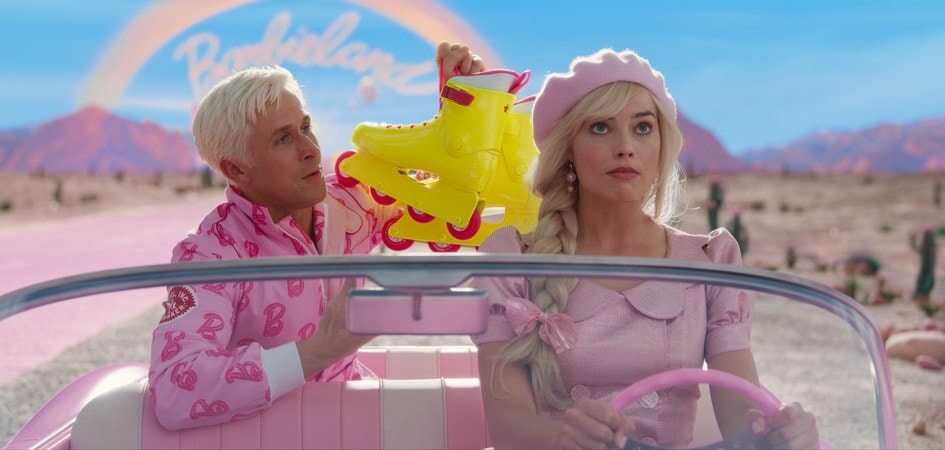
As a kid I played with Barbies like any normal child, i.e. I made them torture each other while jerking off. Happy memories: stripping them down to their hard plastic bodies and perfect blank groins, the way they smiled through their suffering. Inferior to rag dolls in their ability to be fucked and/or loved, and lacking the range and design of the Playmobil object world, they nonetheless had their charms. You could behead them and their heads just kept smiling.
A Barbie, in other words, is a doll—a plaything that “must survive instinctual loving, and also hating and, if it be a feature, pure aggression,” as Donald Winnicott wrote of transitional objects. An odd sort of doll to be sure—a curvaceous, saucy grown-up woman rather than a needy child. As Barbie, the movie, explains at its outset, this was quite novel in 1959, when the iconic toy debuted. “Since the beginning of time, since the first little girl ever existed, there have been dolls,” Helen Mirren intones in a voiceover as a primitive society of girls in pinafores mother old-fashioned porcelain dolls onscreen. “But the dolls were always and forever baby dolls, until . . . ” Thus Spake Zarathustra plays as Barbie—Margot Robbie herself, a monumental living statue straight out of Valhalla—suddenly appears in their midst like Kubrick’s monolith. The girls smash their babies to the ground.
I guess so! It’s true that, together with television sets and record players and many other leisure goods, Barbie helped inaugurate what the historian Lizabeth Cohen called the consumer’s republic of postwar America, even playing a tutelary role in it; as Cohen observed, “her closets full of fashionable outfits and accessories taught the importance of how you dressed and what you owned.” (A television set and a record player appear in Barbie’s first Dreamhouse, which arrived in 1962.) And if Barbie has a particularly charismatic status among these items, this too stands to reason—I am not the only one with happy memories of dolls. Indeed, the movie’s conceit is that the real world in which Barbie is a commodity produced by Mattel, and the imaginary world in which she lives out the fantasies projected onto her, are closely but obscurely connected, their border crossable by those in the know.
Indeed, the movie’s conceit is that the real world in which Barbie is a commodity produced by Mattel, and the imaginary world in which she lives out the fantasies projected onto her, are closely but obscurely connected, their border crossable by those in the know.
This is at a glance a clever idea, and one gets the sense that Barbie’s director Greta Gerwig believes it is a slyly subversive one. Barbieland, an enchanting pink vision of California midcentury modernity, is a liberal feminist utopia in which women run society, do choreographed dances, ignore men, and lounge. This happy state developed as the Barbie universe diversified, Mirren explains, evolving to include career girls and racial difference and a slightly expanded range of body types. The film sees bitter irony in the fact that the Real World has fallen so far behind the Barbies’ world, and comic potential in the fact that the Barbies don’t know it until one of them arrives there.
The trouble with Gerwig’s dualism is that it effectively blots out what we would expect to be the mediating force between its two worlds: the playing child. When Robbie, the “stereotypical Barbie” at the movie’s center, finds herself suddenly despondent and consumed with thoughts of death, Barbieland’s community healer Weird Barbie diagnoses her as having caught a nervous illness from the child who possesses her in the Real World, and sends her across the fantasy–reality divide to find them. Robbie tracks down this child, a cool girl named Sasha, at her junior high cafeteria, only to discover that Sasha hates Barbies on feminist and anticapitalist grounds. “You’re a fascist,” Sasha informs Robbie bluntly. The encounter offers an intriguing twist on a classic motif of children’s literature and film, wherein a fantasy realm is thrown into chaos by a child who has put away childish things. “Children know such a lot now. Soon they don’t believe in fairies, and every time a child says, ‘I don’t believe in fairies,’ there is a fairy somewhere that falls down dead,” Peter tells Wendy in J.M. Barrie’s 1904 play Peter Pan; or, the Boy Who Wouldn’t Grow Up. What happens when a child says, “I don’t believe in Barbie” because she knows such a lot about the traffic in women? What psychic material is buried in the process of this achievement? Does anyone fall down dead? Alas, Gerwig retreats from these questions as soon as she raises them, because the entire thing turns out to be a mixup: it is actually Sasha’s mother, Gloria, a stressed-out everywoman played by America Ferrera, who has been nostalgically playing with Barbies; it is Gloria whose dyspepsia has infected Barbieland. Gloria works for Mattel.
For me, this banal revelation went a long way in unraveling what it is about Barbie that feels, to quote Sasha, fascist. (Sasha is quickly neutralized.) I’ve been attempting gentleness here because there’s a lot to enjoy in this film—the psychedelic sets, the histrionically beta Kens, inspired musical numbers and pratfalls—but there’s no getting around the fact that it gives police state. Of course, no one ever said fascists couldn’t make pleasurable big-budget cinema about the athleticism of blondes. In her essay “Fascinating Fascism,” which centers on the work of Leni Riefenstahl but locates a related sensibility in movies like Fantasia and, indeed, 2001, Susan Sontag writes,
Fascist art displays a utopian aesthetics—that of physical perfection. Painters and sculptors under the Nazis often depicted the nude, but they were forbidden to show any bodily imperfections. Their nudes look like pictures in physique magazines: pinups which are both sanctimoniously asexual and (in a technical sense) pornographic, for they have the perfection of a fantasy.
Minus the nudity, these are apt descriptions of Barbieland—though to point this out risks willfully refusing to recognize another Sontagian aesthetic, camp. It’s not just that bodily imperfections are forbidden here, it’s that Robbie developing cellulite is a national emergency; it’s not just that the pornography is asexual, it’s that Barbie and Ken don’t have genitals. Such gags obviously send up Barbieland’s veneer of perfection, and yet an aura of authoritarianism clings to the film like a Ken to his Barbie. Another moment from “Fascinating Fascism” gets us closer to solving this riddle. Describing Triumph of the Will, a film she found “superb” and deplorable, Sontag writes, “in a temperate zone clean-cut people in uniforms group and regroup, as if they were seeking the perfect choreography to express their fealty.” Beach, check; uniforms, check; choreo, check; but to whom are the Barbies expressing their fealty?
What happens when a child says, “I don’t believe in Barbie” because she knows such a lot about the traffic in women?
The answer, of course, is Mattel. Though the company is the target of mild satire, its all-male executive team clownish and easily pranked, there is no question that Barbie’s makers ultimately control the meaning of the doll, and that Barbieland is nothing but a vassal state. With the exception of Weird Barbie, stigmatized in Barbieland after being mangled by a kid who “played too hard,” no one in the seaside colony shows signs of having experienced the destabilizing effects of child’s play at all. The final tell is Gerwig’s decision to make Robbie the familiar of a Mattel employee (low-level, to be sure, but a true believer in the Barbie brand)—a quirky choice almost comically expressive of what is sometimes known as “corporate feminism.” From here, it is hardly a surprise that in the movie’s third act, the Barbies spring into action against a male supremacist coup in pussy-hat-coded pink jumpsuits.
Barbie, in short, has disrupted a stalwart genre of children’s stories about the power of fantasy to remake the world, often by animating the jumbled things around her. It has done so by cutting out the middleman of the child entirely, and banishing all toys that are not Barbies. The idea that dolls offer girls a prefabricated range of options for what they can be, rather than a set of objects on which to play out wishes and fears, aggression and desire, grants an enormous amount of psychic power and civic responsibility to corporations. Barbie not only seems to believe this but suggests that it is good and even natural, part of the evolutionary process that began when Barbie first rose in the mist and inspired girls to destroy their crude unbranded playthings, dangerously empty vessels for the imagination.
Mattel has forty-five more film projects lined up. The American people eagerly await its continued attempt to scour the world of dolls.
—Ari M. Brostoff
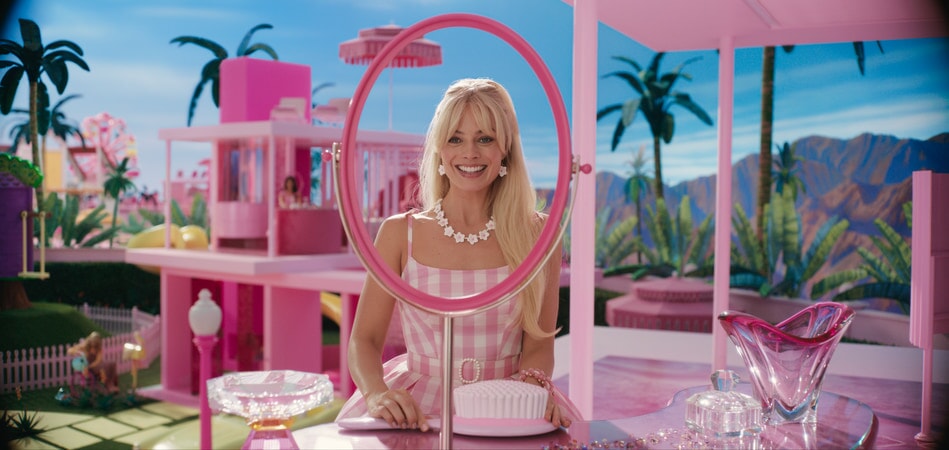
I ’ve walked past the Barbie branded selfie booth, sat through the reel of old commercials that precede the previews, and watched Margot Robbie learn to cry, and I’m still not sure what “doing the thing and subverting the thing,” which Greta Gerwig claimed as the achievement of Barbie in a recent New York Times Magazine profile, could possibly mean. This was the second Gerwig profile the magazine has run. I wrote the first one, in 2017, which in hindsight appears like a warning shot in a publicity campaign that has cemented Gerwig’s reputation as so charming and pure of heart that any choice (we used to call them compromises) she makes is justified, a priori, by her innocence. This is a strange position for an adult to occupy, especially when the two-hour piece of branded content she is currently promoting hinges on a character who discovers that her own innocence is the false product of a fallen world. But—spoiler alert!—the point of Barbie’s “hero’s journey” is less to reconcile Barbie to death than to reconcile the viewer to culture in the age of IP.
The point of Barbie’s “hero’s journey” is less to reconcile Barbie to death than to reconcile the viewer to culture in the age of IP.
“Doing the thing and subverting the thing”: I haven’t finished working out the details, but I think the rough translation would be Getting rich and not feeling feel bad about it. (Or, for the viewer: Having a good time and not feeling bad about it.) One must labor under a rather reduced sense of the word “subvert” to be impressed with poking loving fun at product misfires such as Midge (the pregnant Barbie), Tanner (the dog who poops), and the Ken with the earring, especially given that the value of all these collectors’ items has, presumably, not decreased since the film opened. Barbie may feature a sassy tween sternly informing Robbie’s Stereotypical Barbie that the tiny-waisted top-heavy billion-dollar business she represents has made girls “feel bad” about themselves, but if anyone uttered the word “anorexia,” I missed it. (There was a reason Todd Haynes told the story of Karen Carpenter’s life and death with Barbies, and it wasn’t because an uncanny piece of molded plastic has the magical power to resolve the contradictions of girlhood and global capitalism.) There’s a bit about Robbie going back into a box in the Mattel boardroom, but Barbies aren’t made in an executive suite; they come from factories in China. On the one hand, it’s weird for a film about a real-world commodity to unfold wholly in the realm of ideas and feelings, but then again, that’s pretty much the definition of branding. Mattel doesn’t care if we buy Barbie dolls—they’re happy to put the word “Barbie” on sunglasses and T-shirts, or license clips from the movie for an ad for Google. OK, here’s my review: When Gerwig first visited Mattel HQ in October 2019, the company’s stock was trading at less than twelve dollars a share. Today the price is $21.40.
Did you hear that noise? I think it was a nail going into the coffin of mumblecore.
Honestly, I only care about this because of Noah Baumbach. I’ve always been a huge fan of his. I liked White Noise, for god’s sake! But I prefer my irrepressible knowledge of death to be absent of logos and bad faith. If I’m going to be spiritually murdered by capitalism and nostalgia, I don’t want to be winked at while it’s happening. Barbie was a blissfully comatose cultural memory until Gerwig began administering this series of life-saving electrical shocks. Of course, the sad truth is that we didn’t need a movie to make Barbie live again. Robbie may embrace mortality onscreen, but in the real world, Barbies never die. They live forever in our oceans, and our lungs.
—Christine Smallwood
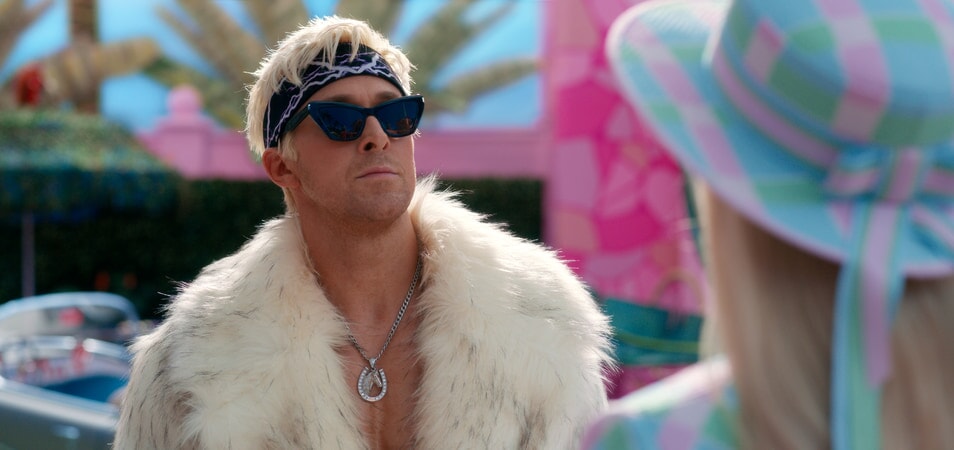
More than anything the movie reminded me of advertising from the ’80s and ’90s, stuff Gerwig would have grown up seeing on TV, that made fun of its own status as advertising. Sprite’s 1994–99 “image is nothing” campaign, which deployed cliches from existing TV commercials in order to undermine them in order to deploy them again, is maybe the most famous example. (I’ve long felt that soda commercials are in general a skeleton key to the entire 1990s: between the poles of Coke’s failed OK Soda experiment and Negativland’s 1997 record Dispepsi, a plunderphonics masterpiece made exclusively of sampled ads and jingles, you can sort of perceive a whole generational ethos emerging.) In one of the Sprite ads, which has a virtually identical plot structure to Barbie, the cartoon mascot of a made-up beverage called SunFizz springs to life, breaks out of the mystery land of marketing and into the real world, and terrorizes a mother and child, chasing them around a sunny suburb. A voiceover instructs the viewer: “Trust your gut, not some cartoon character.” Then the Sprite logo appears.
That era’s advertising critics (a once illustrious profession that’s now extinct—a shame at a moment when everything is advertising) called marketing like this “anti-ads.” “The most titillating ads on TV don’t use sex or drugs or rock ‘n’ roll: they admit they tell bold-faced lies,” wrote the great Village Voice ad critic Leslie Savan in an analysis of Isuzu’s mid-’80s “Joe Isuzu” campaign, in which a spokesman made outlandish claims about pickup trucks while the commercials fact-checked themselves in subtitles. Those ads, Savan wrote, “revel[ed] in hucksterism while mocking it.” That’s a good description of the Barbie movie, which extends across two hours the conventions that anti-ads perfected in thirty-second slots: high-dollar irony; arch, referential, if-you-know-you-know appeals to wised-up viewers; a general sense that the fourth wall is being demolished only so that the property it occupies can be rezoned into a commercial district. When Helen Mirren, in her voiceover narration, addresses the studio executives and scolds them for casting such a conventionally hot lead—a low point in the film and one that falls flatter than anything in 2006’s Stranger Than Fiction, another Will Ferrell vehicle featuring the metafictional intrusions of a British narrator—we see the whole spirit of anti-advertising distilled in one gesture, self-promotion masquerading as self-critique.
In particular, this film about a toy operates as an extended meditation on the marketing precept that kids are any brand’s most profitable consumer demographic.
Like a good anti-ad, and like some of the films it invokes (Playtime, Will Success Spoil Rock Hunter?, even Elf, also with Ferrell, here reprising his role after an apparent promotion to the other side of the boardroom), Barbie is explicitly about advertising. In particular, this film about a toy operates as an extended meditation on the marketing precept that kids are any brand’s most profitable consumer demographic. It’s one of advertising’s most foundational truths, the reason why vape pens and social media apps and Tide pods and blockbuster cinema all seem to be designed chiefly for the enjoyment of children: younger customers simply have more years of purchasing power ahead of them. When Barbie says she is afraid of death, what she is really afraid of is the inevitable endpoint of the formula that marketers call “customer lifetime value.”
Death isn’t useful to advertisers, which is perhaps why Barbie’s engagement with the subject seems so . . . childish. Actually, the film struck me as thoughtful about aging only insofar as it seemed written for the explicit purpose of being assigned in undergraduate media studies classes. For a coming generation of students writing papers about post-third-wave feminism, or psychoanalytic transitional objects, or the inevitable tendency of institutions to absorb critique, Barbie will have succeeded in following them all the way out of girlhood and into near-adulthood, like how for a long time campuses were full of people playing Quidditch.
Eventually I wanted to know what the decade of ad criticism had to say about Barbie herself. I found a good Leslie Savan piece about Barbie from 1994 (it begins with Savan’s origin story as a critic of consumerism: unclipping her doll’s hair to discover that “Barbie was as bald behind as Nikita Krushchev”), which glancingly mentions an anthology of transgressive Barbie-themed fiction and poetry, published the previous year, called Mondo Barbie. I liked that title, which seemed like it could apply to Margot Robbie’s frankly threatening appearance at the beginning of Gerwig’s movie. (Why is she so big? Even Kubrick’s monolith is not that big.) The works collected in Mondo Barbie are called things like “Twelve-Step Barbie” and “Barbie Wonders About Buying a Coffin.” In them, tween boys ejaculate onto the naked breasts of their sisters’ Barbies, then onto their sisters’ Kens. Barbies form a cult based on the worship of identicality, eschew first-person singular pronouns, and commit gruesome murders as an anonymous collective. This is goofy, zine-y stuff, sub–Dennis Cooper juvenilia. But a lot of it still strikes me as a more mature approach to this piece of Mattel iconography than Gerwig’s movie, and more honest. The stories in Mondo Barbie look head-on at sex and death as real drives, dark and often violent longings. That’s a low bar for art but it’s something that advertising, even in its late and highly advanced form, can’t really do. It is still worth making these distinctions.
—Lisa Borst
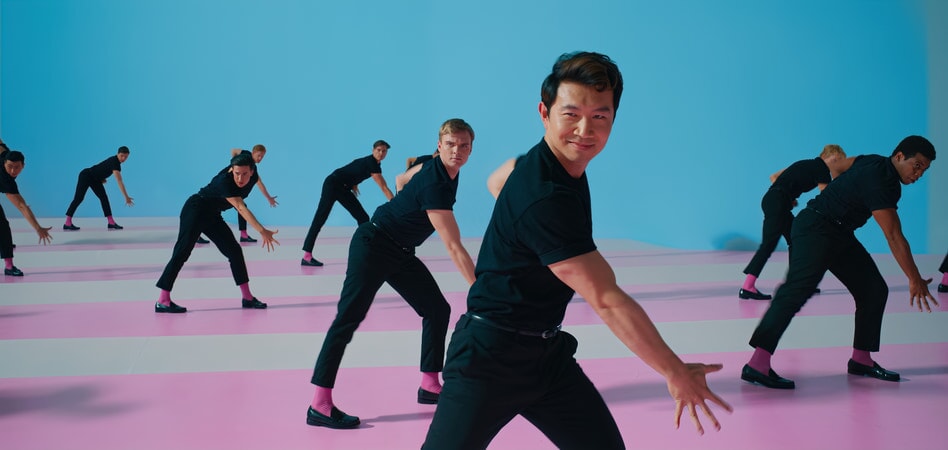
I will be discussing Barbie as a simp, not a reviewer. I didn’t watch it with any kind of critical lens. Within the first few minutes I was fully sobbing, and by the end I was like oh this is my favorite movie of all time. Besides maybe The Shining.
To get the obvious out of the way: Barbie is a polemic. It probably qualifies as propaganda. And I hope it brainwashes people as effectively as the fascists on the far right seem convinced it can. I heard a cis dude describe it negatively as “didactic,” and I would have to agree. I plan to gesture toward Barbie in the future if someone happens to need the details of my campaign platform.
The movie provides a refuge from the echo chamber of cultural objects that reinforce the bizarro world of the patriarchy and creates an internal system of meaning in which femme existence is powerful and world-defining. The only other film I’ve ever seen that has given me anything close to that XX chromosomal high is Věra Chytilová’s Daisies, a Czech New Wave film that features two girls wearing flower crowns, trolling men, throwing profiteroles onto the ceiling, and debating the efficaciousness of various forms of radical resistance. It rules. But also, it came out in 1966, so I’ve been waiting a long time for another one!
Barbie opens with a recreation of the opening sequence of 2001: A Space Odyssey. In the former we get little girls holding baby dolls instead of monkeys, a giant Barbie instead of the monolith, and Helen Mirren in voiceover instead of atonal soprano keening. The entire theater was laughing until we got to the part where the little girls bash their dolls’ heads in. At that moment everyone stopped laughing, except for me. The gag was a little too violent and visceral to be universally funny. One of my favorite Maria Bamford jokes is about home renovation reality shows going too far in the reveal: “you like the wallpaper? It’s your baby’s skin!” I like humor like that, especially when it relates to feminine domesticity or maternal love. Clearly I’m a Barbie that got weird from getting played with too hard.
The movie provides a refuge from the echo chamber of cultural objects that reinforce the bizarro world of the patriarchy and creates an internal system of meaning in which femme existence is powerful and world-defining.
I saw Barbie twice. The first time was the night before my grandmother’s funeral. I cried at both events, but I cried more at the movie. The shot that really set it all in motion was, weirdly, the bird’s-eye view of Barbie’s dreamhouse in the opening credits. I’m not sure why this goofy, Busby Berkeley–esque zoom into a plastic dollhouse is so moving to me, but I think it has something to do with the ecstatic happiness of it all. Maybe it’s about the need for a place to live, the need for a new world, or a new planet. Swooping into this rubberized femme toy utopia, I had a feeling of being somewhere else, somewhere better, somewhere I’ve been trying to get to for a long time.
What Barbie does really well—indeed with dialectical rigor—is show how impossible it is to imagine the glories of a high femme utopia without reckoning with the ways that our collective view of femme-ness has been forced into permanent lockstep with capitalism. We cannot imagine a world in which the instinct to bedeck oneself in ornamentation, to beautify one’s person, isn’t a consequence of an economy in which one’s body is the primary commodity.
Every morning it’s like I wake up in the Barbieverse, where femmeness is an expression of power, domestic labor is financially well-compensated, and Issa Rae is President. Then I regain consciousness, and, like Ken, I go “everything is almost like, reversed here.” It sucks. I was hoping the movie would help with that cognitive dissonance, especially with this thing that happens, not constantly, but consistently, in my life, where, essentially, people tell me I look like a dumb annoying “jezebel” and should look and act differently if I want to be taken seriously. I think our culture still really hates femmes. Like really hates femmes. Like ragey hate.
It’s still acceptable, or at least common, to mock, belittle, or dismiss people whose self-presentation involves visible effort to look femme. It’s a ubiquitous kind of hate: mutable and persistent across polarities on the right and left, across the gender and sexuality spectrum, across industries. The antipathy toward femmes is an essential tool in the maintenance of cisgender norms. Because if the practices that constitute femmeness were truly recognized as a creative act that—for some people—constitutes their sense of wholeness and visibility, the category of femme-ness would be divorced from biologically assigned gender and recognized as simply a way of being human. The continued objectification and abjection of femmes by the patriarchy is essential in quashing the potential for revolutionary solidarity.
The continued objectification and abjection of femmes by the patriarchy is essential in quashing the potential for revolutionary solidarity.
The core of the conflict between Barbie and Ken comes down to property ownership. It’s only when he wrests control of the Casa away from Barbie and into his own (fingerless-gloved) hands that the pure, undiluted Ken-triarchy takes shape. This housing crisis will spare no one, not even in Barbieland! And still, I want to live in Barbieland so badly. I kind of almost think I could? I was in a movie with Hari Nef once where she played my gorgeous, self-assured, and professional boss, and I played an unhinged, messy femme who cries a lot. In this movie she plays Margot Robbie’s gorgeous, self-assured, and professional doctor, and Margot Robbie plays Barbie who cries a lot. So . . . maybe.
Both Barbie and 2001 end with extradiegetic montages through which their protagonists move from one dimension of reality to another. If 2001 is about the impossible burden of postmodern (masculine) individualism, it posits the only recourse as obliteration. As Ken says, “it was really hard running stuff.” But what that vision doesn’t take into account is the possibility of putting down that burden, of giving up on the whole phallocentric labor of self-definition and like, giving someone else a turn. Like the hard, enclosed pods of 2001, Ken’s Dojo Casa House has a clear property line around it defining what’s his and what’s not. He adds a swinging saloon door with a flashy horse design on the outside to make sure everyone notices it. When Barbie’s in residence, it’s all open-concept real estate. She never even uses her door: just floats out her window, vibing.
I think people expect a lot from this movie—and I get why. It feels like we need a monolith to come and change things if we’re going to get out of this mess, and we only get so many chances at one. Usually, we’re living in an echo chamber of the patriarchy respawning patriarchal art. Men’s stories are the center of all our narratives, and they’re asked to do very little heavy lifting because it’s assumed that everyone will be interested in those stories. But not everyone is, OK?
—Cecilia Corrigan
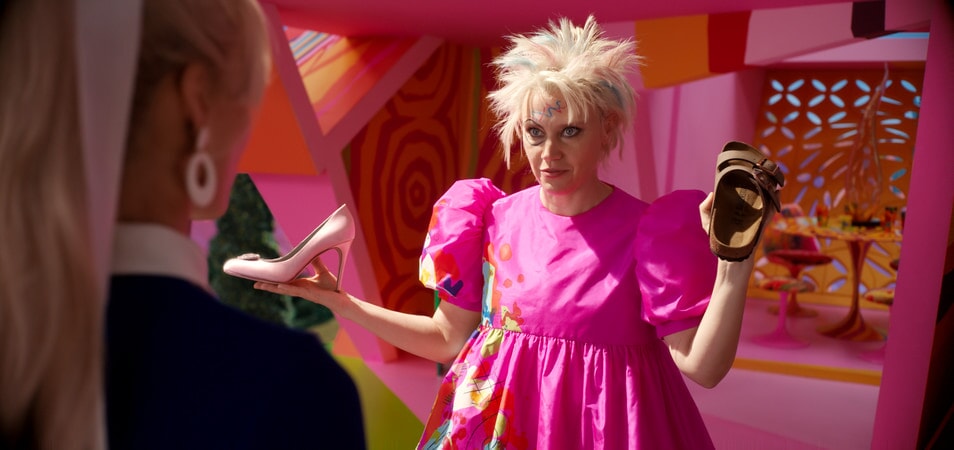
The outdoor terrace of the Manor Oktoberfest overlooks the vast square of The Shops at Atlas Park, an open-air shopping center in Glendale, Queens. On the afternoon of Sunday, July 23, I observed from that perch as hundreds of people poured out from Forever 21, Ashley’s Furniture, Corndogs By Mr. Cow, Five Below, Laser Bounce Family Fun Center, and Hokkaido Baked Cheese Tarts, past the soon-to-open Spirit Halloween and United Skates of America outdoor roller rink, and up the escalators leading to the Atlas Park Regal Cinemas. It seemed as though everyone was wearing pink.
It’s been a long time since the movies have had a Super Bowl—a weekend in which heading to the cinema was, for better or worse, a ritualized event. Some have argued Barbie’s marketing footprint was too great, such as Succession actress J. Smith-Cameron, who tweeted that she felt “bullied” by the pre-release hype. I can’t say I found it particularly aggressive that the Atlas Park Cold Stone Creamery was serving Barbie-branded “All That Glitters is Pink” ice cream with “dance party sprinkles”—but I come from the era in which popular singles were rereleased with Godzilla screeching over them (“Brain Stew (The Godzilla Remix)”). In fact, when my friends and I dropped by Chili’s for margaritas, it seemed notable that the iconic casual dining chain didn’t have a promotional tie-in. Even so, the artist was present—each time the door opened, I would look up, like in the final episode of The Sopranos, and see another man, woman, grandparent, teen, girlfriend, or boyfriend walk in wearing head-to-toe pastels. Bullied or not, everyone had received the boss’s memo.
The movie was OK: you can feel the heavy hand of the Mattel brand, and the horse trading that went into placing toothless autocritique in exchange for feel-good brand messaging. The former is often undermined by the latter: an initially trenchant young radical type who calls Barbie a “fascist” is only able to actualize her feminist ideals by appreciating how much the doll meant to her mother and communing slumber party–style with the other Barbies. A great hullabaloo is made of the all-male Mattel boardroom, only for the audience to learn that Barbie has all along been guided by the ethos of its woman creator Ruth Handler (who, the film points out, has been busted for tax evasion).
Did I just pay $17.50 to witness the spectacle of capital subsuming dissent?
At a certain point my friend jolted awake and asked me if he missed anything, and I probably said, “Not really.” But really my mind was racing with questions like, Why is there a transfemme Barbie but no transmasc Ken? Did I just pay $17.50 to witness the spectacle of capital subsuming dissent? Have the filmmakers deliberately cast “Weird Barbie” with an actress who dated Bari Weiss and played “Hallelujah” on the piano while dressed as Hillary Clinton after the 2016 election in order to politically center “weirdness”? Why is there no mention of doll materials designer Jack Ryan and his past employment engineering missiles for Raytheon? It’s no small thing that Greta Gerwig managed to make something about which even ostensibly absurd questions to ask of a literal children’s film are valid. A few days later, someone argued to me that, because Barbie was inspired by the German doll Lilli, based on a comic strip about a call girl, it was grave moral failure of the film to not engage meaningfully with sex work. Fair!
Indeed, Barbie has captured the intellectual imagination. Consider the old-school alt-weekly-style critics’ tête-à-tête the movie inspired between the New Yorker’s Richard Brody, who claimed that it was not the work of a sellout because Gerwig “made Barbie with artistic freedom and personal vision,” and Amy Taubin, who pointedly accused the Everything Is Cinema: The Working Life Of Jean-Luc Godard author of not understanding dialectics. Žižek dropped his Barbie piece just two days after its release. Conservative circles joined too. Fellow alt-weekly veteran Armond White, formerly of the New York Press, now The National Review’s film critic, blasted Barbie for lacking the “fascinating sexual empowerment [of] Robert Zemeckis’s postfeminist doll movie Welcome to Marwen.”
Leftists and right-wing populists seem to agree Barbie’s internal critiques of its corporate overlords don’t quite stick, but in practice, its runaway success has probably gone some way toward thwarting parent company Warner Bros.’s evident plans to destroy their own theatrical business model and sell it off for parts to increase value for shareholders. I don’t know if that’s dialectics, but I have to imagine that some of Barbie’s handlers are feeling at least a little cucked.
—Jon Dieringer
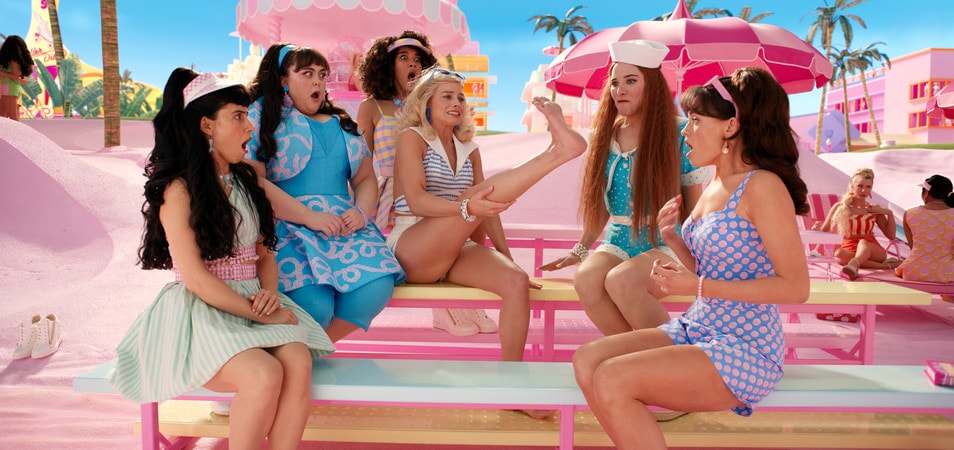
Barbie or baby: mine your childhood and its discontents, recall your choice (or lack thereof), and retrofit the findings. I had a single, sepia-skinned dollie, which arrived with a stroller and hospital blanket bearing my name. My obstreperous younger sister clung early to Barbie, filling our room with Barbie’s three-tiered home, her endless compeers, her Corvette, her pets, and the veterinary clinic at which said pets received treatment. Our space, initially shared by three (myself, my sister, and our grandmother), became home to a thriving plastic citizenry, fecund and fawned over by their mother-owner and all spectators. My sister would unkey the dreamhouse and its garish pinkness seemed to emanate, casting her in a roseate glow so beguiling I occasionally joined the play. I lost my shit at the horse stable: a gleaming Palomino mare, her buckskin colt, a picketed enclosure, saddles, reins, a brush for their nylon tails. What had been annoyance, vague and fitful, steeled into affrontedness. Thus I became the kind of child who becomes the kind of adult who proclaims, “I hate Barbie.”
My reasoning is gauzy. Did I, adhering to the scripts of abject, black girlhood, begrudge the doll’s Aryan beauty? No. Did the glut of toys activate my budding neuroses, evidencing my compulsion for order in the bedlam of poverty? Not quite. I had my own corps strewn about the room, including stuffed animals, tea sets, endless books, and a guinea pig named “Sherman.” Did I feel myself deprived in comparison to my sister’s bounty? No. I can recall exactly the DCFS allotment for Christmas presents: $200 per child, paid to my grandmother, who would inform us of our budget, inquire what we wanted, and procure the requested items, my sister’s Barbies among them. Finally, a compelling source of my inane doll-hate: juvenile class rage, ignited at the sight of Miss Thing’s Pepto McMansion inside of our project apartment. The dreamhouse reflected my own wrecked nuclearity—birthday letters from prison, a grandmother turned mother, social worker visits, lies in family therapy. A compelling motive, but not quite a true one, implying as it does a childhood me neatly aligned with my adult political posture. The truth is there are about as many reasons to hate Barbie as there are to hate your mother, and with Barbie Greta Gerwig broaches both antipathies.
The first thing that struck me about Barbieland was its incessant dryness. No water springs from Barbie’s showers or sinks, no milk flows from her carton. This state of unwetness reflects the chaste relations between Barbies and Kens, reminding that Barbies are not born via the sluice and blood of human reproduction, but made. When Stereotypical Barbie, or The Barbie, begins to glitch, spouting phrases that hint at a dark, burgeoning consciousness, her shower runs real, cold water. She cries real tears.
The first thing that struck me about Barbieland was its incessant dryness.
After visiting the sage-like weird Barbie, Stereotypical Barbie learns that this is evidence of the leaky barrier between the dolls and their owner proxies. With the shorn head and splaying legs of Weird Barbie, the film departs from conservative notions of girlhood as a time of shared innocence. Her mangled body testifies the violence girls do to their dolls.
In contrast, Gerwig depicts the patriarchal siege of Barbieland as more pesky than hostile. The land of sweetness and pink is now an emergent manosphere, replete with cucks, chads, betas, and stacys. Although The Kens were easily radicalized—I imagined the male populace scrolling reddit by moonlight, lamenting their degraded American masculinity—theirs is a pretty fangless patriarchy. Several of their number also prefer feminine rule and the only sexual misconduct is Ken’s repeated attempts at a kiss, which we understand to be a result of his own lack of identity. Between the dopey Mattel execs and the beach himbos, they’re not an especially cunning lot so the reins are easily reseized. With empathy, reason and light trickery, the MRAs are made allies, and in the end, all is right in the land.
Buttressing the white feminist fantasy of gender separatism is belief in the innate barbarity of men and the essential goodness of women, self-aggrandizement masked as a politic. Gerwig takes the stance that men are people who happen to be male, fallible, seduced and harmed by power in turn. Let the girls lead, not because they’re better at it—although, let’s be clear, they do seem to be better at it—but because it’s their turn.
—Jasmine Sanders
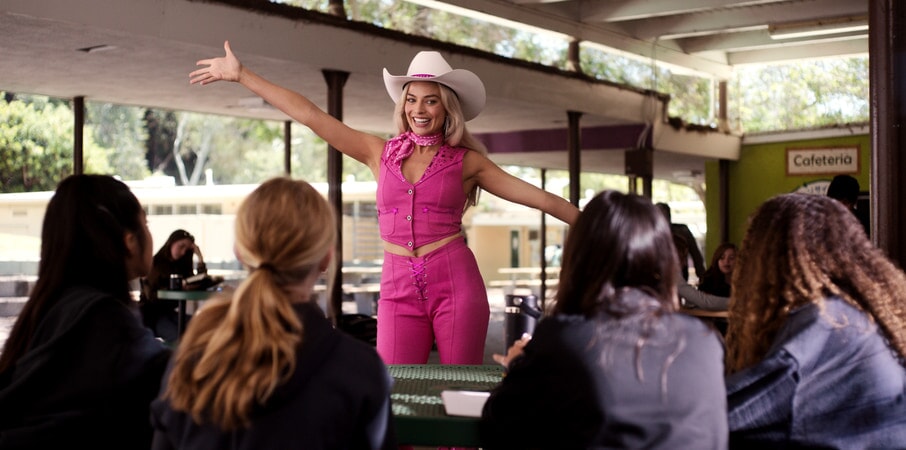
It was hardly surprising to see women across generations—literal infants, teens, and mothers—all wearing vinyl pleather pink skirts. We were, after all, in line to see Barbie, which mobilized a mass ad campaign in collaboration with about every brand imaginable to lay implicit claim to the color pink. Burger King subjected the Brazilian people to the “Barbie Burger,” a cheeseburger dressed in a neon pink sauce, and “Ken’s potatoes,” just plain fries—this being a kind of fast-food transliteration of the movie’s promotional slogan that “She’s everything. He’s just Ken.” At a certain point, one could hardly down a capful of Pepto Bismol without reflexively thinking about Barbie, and Margot Robbie, and wait—is Pepto Bismol feminist? Barbie succeeded, at least for a couple weeks this summer, in whipping up a current of gender enthusiasm: the idea was that Gerwig was making something big for girls, who are everything, and not boys, who go to Oppenheimer to get more stupider, or something.
My roommate and I walked home from the movie in near-total silence. It was exhausting, and also not funny. It was as if Gerwig had fed feminism infographics from 2014 into GPT-3 in order to create a screenplay committed to promoting gender essentialism, wherein patriarchal violence boils down to getting cat-called by construction workers. Gerwig’s feminist allegory involves a Barbieland where Barbies rule and Kens drool, and then a real world where the opposite is true. It’s dumb, but beyond that, it’s politically suspect: the interchangeable gender regimes that shape Gerwigian feminism suggest that power is fluid, whereas gender is materially real—a worldview that doesn’t just stray from our now-familiar feminist precepts, but fully inverts them.
The interchangeable gender regimes that shape Gerwigian feminism suggest that power is fluid, whereas gender is materially real—a worldview that doesn’t just stray from our now-familiar feminist precepts, but fully inverts them.
Gerwig consciously moved from her indie mumblecore roots to become a hitmaker whose work focuses on women and their feelings—Ladybird and her Little Women remake were successful at this—but with Barbie, which features main characters who are not human, all Gerwig had to work with was gender. And she botched it! The movie is a visual distillation of Mattel’s corporate anxiety about selling a sexist product by getting ahead of the sexism of its product; its attempt to distract from this incoherence was to bombard people with ads. It would have been less absurd for DreamWorks to market its 1998 film Antz by selling bottles of bug spray decorated in hammer-and-sickle motifs. Probably movies shouldn’t try to be “about” feminism, anyway.
This sucks because even before Barbie, feminism was already a topic of discussion that people seemed fatigued by, in large part because of its corporate capture. After a decade of Lean In and investment apps for women, seeing a production company dedicate $150 million—a movie budget typically reserved for promoting American imperialism—to a self-consciously “feminist” venture felt like a nail in a pink coffin. In any case, my favorite part of the movie happened in the audience: there was a woman and her toddler sitting in the seats next to mine, both dressed in Barbie merch, and the toddler kept shrieking with joy at the wrong parts, like the patriarchal victory montage when the Kens manage to January 6th Barbieland, or when Barbie discussed her depression. Her mom kept hissing at her in Russian to be quiet, but I was glad for her daughter’s enthusiasm. I like to think she discerned some esoteric gender message beyond what I could understand.
—Arielle Isack
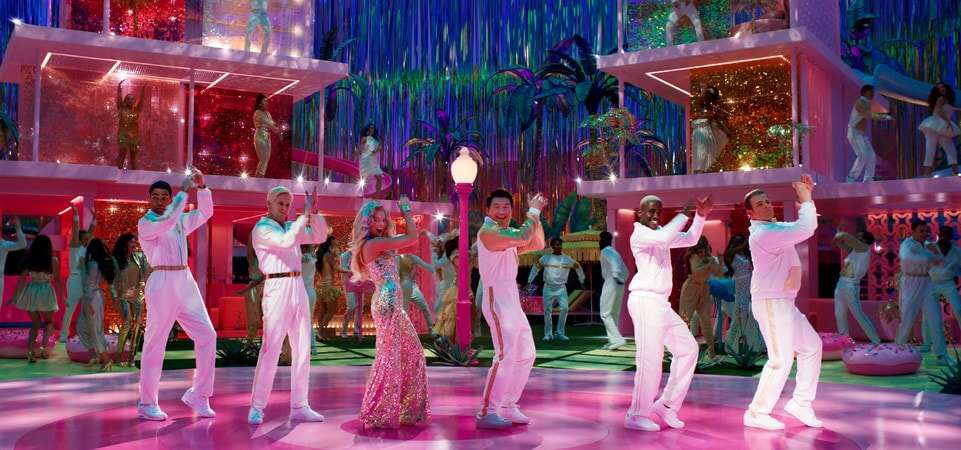
My mom and I saw Barbie a few hours after my dad’s ashes were interred at a cemetery outside Atlanta. My dad loved movies—in Moscow, he and his friends used to sneak into Party screenings of banned films, hiding in the bathrooms between features—and especially movies that were emotionally forthright, even sentimental. I don’t remember if he saw Lady Bird and Little Women, but I’m sure he would have liked them both.
When America Ferrera and her daughter (Ariana Greenblatt) showed up in Barbie, I thought I was done for. My daughter is only 5, but already I live a life of resigned dread about the future moment when she’ll start to pull away. And now here was Gerwig’s great theme imposing itself on a movie that seemed far more invested in brand management than the emotional kind. Lady Bird and Little Women took relationships like Ferrera’s and Greenblatt’s as their central subjects. In Barbie, by contrast, the dynamic between daughter and mother plays out in tiny flashes—the two briefly touching arms, a kind look after a long regime of teenage hostility—as if a three-second-long gesture can substitute for a running time’s worth of elaboration. Barbie is a very cynical movie, but nothing in it is as cynical as the way Gerwig mines her earlier flourishes with the heedless expectation that the audience will respond like it did last time around—that it will abide by Rhea Perlman’s directive and “feel.” In a movie composed of shortcuts, these fragments—I hesitate to call them scenes—are the shortest. (My mom compared the film’s tonal indecisiveness to being pierced by sharp needles.)
I’ve seen Barbie described as death-haunted. Maybe it was my afternoon brush with that subject, but I detected no hauntedness of any kind—not by death or anxiety or fear or compunction. Barbie invokes death in the same way it invokes Proust and the Snyder Cut and Mussolini and Matchbox Twenty, incidentally and without any visual or narrative commitment. (I did enjoy the Matchbox Twenty sing-along—one of the rare moments when the film slowed down and allowed the viewer to inhabit the action, rather than merely taking note of it.) To the extent that Barbie is a confident film, it is confident above all in its commercial inevitability and in a hurry to get there, at least until the punishing attenuations of its final third. I loved the delicacy of Little Women’s pacing, which felt loving in the way it echoed Saoirse Ronan’s self-discovery and her emergent understanding of her surroundings. In Barbie, Gerwig and her cinematographer, the usually excellent Rodrigo Prieto, never linger on anything, perhaps because there’s nothing worth lingering on.
In Barbie, Gerwig and her cinematographer, the usually excellent Rodrigo Prieto, never linger on anything, perhaps because there’s nothing worth lingering on.
Other than Tati’s glorious Mon Oncle, the movies that came to mind when watching Barbie weren’t the ones Gerwig has cited as inspirations (a now-inevitable part of the press cycle that occasionally leads to moments of beautiful grotesquerie, as when the Russo Brothers claimed that Red Desert and Shoot the Piano Player were crucial references for The Gray Man). Instead I thought about two comedies Gerwig likely saw in theaters, as I did: Anchorman, which made far better use of Will Ferrell, and the first Austin Powers, another minor culture-clash comedy with a character called #2 and a cinematographer too interesting for the material (Peter Deming). Those nasty, shallow movies run their best bits into the ground, but still I prefer the tedium of their excessive embellishment to Barbie’s frantic zigzagging from bit to bit, as if the movie were checking boxes—rather than stuffing poor Margot Robbie into them.
Standards are low, and like every other sensible person I’m glad that, for once, a film with elaborate sets and good costumes and actors’ faces and bodies unobscured by CGI has pulled viewers into theaters. Atlanta’s Tara Theatre, which was threatened with extinction last fall after Regal pulled out, was packed last Friday. I spent some of my happiest moments at the Tara, an ugly vernacular modernist art house where I first saw Waking Life, The Blair Witch Project, Kore-eda’s After Life, and The Royal Tenenbaums, a movie that my dad loved for its tenderness. Like that film, Lady Bird could plausibly be situated in the tradition of mainstreamish, idiosyncratic filmmaking that I once called independent because I didn’t know better. But Barbie, with its pop-referential checklist, its refusal to decide on a subject or a mode, and its existential dedication to IP above all else (including feminism), isn’t much more than a Marvel movie by another name, even if the spectacle it has generated is a far more muddled one.
The other night at the Astoria multiplex, I walked by a Barbie screening that was just letting out and immediately noticed a Soviet couple my parents’ age among the throng of zoomers. The husband was outraged by the film, or faux-outraged, and announced to his bemused wife that he had to give a theater employee a piece of his mind. I intercepted him just before he stomped over to the ticket taker. Why bother the workers? I said. I’d been thinking a lot about Barbie; I’d be happy to hear him out. We went back and forth for a while, but for all my efforts I couldn’t elicit the opinion he’d been so eager to share only a few seconds earlier. “You’re Russian,” he finally said. “I want to tell an American what I think.” I insisted that when I spoke English—which was most of the time—I was American enough, and then he said that he was, too, as if I’d somehow questioned his Americanness, by which point we’d really lost the thread. “You know what I think,” he finally said as they walked off. I did. It would have been nice if Barbie had enraged people like this man with its radical analysis, rather than its generationally confounding feminist politics. In any case, I hope everyone returns to the Tara this week to see the Beanie Babies movie. The theater is independent again, and it needs the money.
—Mark Krotov
Dig, Root, GrowThis year, we’re all on shaky ground, and the need for independent journalism has never been greater. A new administration is openly attacking free press — and the stakes couldn’t be higher.
Your support is more than a donation. It helps us dig deeper into hidden truths, root out corruption and misinformation, and grow an informed, resilient community.
Independent journalism like Truthdig doesn't just report the news — it helps cultivate a better future.
Your tax-deductible gift powers fearless reporting and uncompromising analysis. Together, we can protect democracy and expose the stories that must be told.
This spring, stand with our journalists.
Dig. Root. Grow. Cultivate a better future.
Donate today.



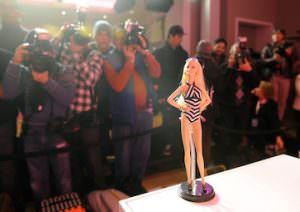




You need to be a supporter to comment.
There are currently no responses to this article.
Be the first to respond.